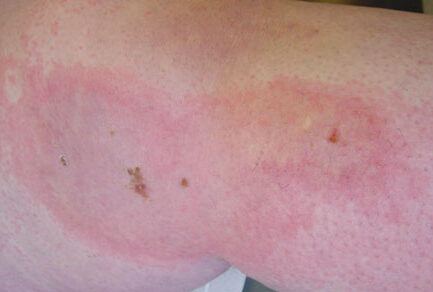
Simon, 32, presents with a 24-hour history of an itchy red weal on the torso (pictured). He is otherwise well, with no systemic symptoms.
He went bushwalking on the weekend in a national park in a tick-endemic region on the east coast. Simon has previously sustained a number of tick bites and has usually removed the tick himself with fine tweezers.
The last time, however, he experienced an extensive local reaction around the bite site after removing the tick, developing a 30cm weal, which took nearly a week to resolve. For this reason, he has not attempted removal this time.
What is the most likely diagnosis?
Correct!
A large local weal, lasting several days, at the site of a tick bite is usually the result of a mild tick allergic reaction. Anaphylaxis may occur following Australian paralysis tick (Ixodes holocyclus) bites.
Tick removal or disturbance increases the risk of anaphylaxis. Anaphylaxis occurs in sensitised individuals when the tick is disturbed — for example, after inadvertently scratching or attempts at tick removal, including applying methylated spirits or kerosene.
The offending allergens are proteins contained in the tick saliva. Any disturbance to the live tick can cause more salivary injection; therefore, it is recommended that ticks be killed prior to removal using an ether-containing spray or liquid nitrogen for adult ticks or permethrin cream for larval- or nymph-stage ticks. This also reduces the risk of tick sensitisation and subsequent development of tick and mammalian meat allergy.
In patients with suspected tick allergy, this should initially be performed in an appropriately equipped, medically supervised environment until it is established that ticks can be safely killed and removed unsupervised.
Ticks pass through a number of life stages: egg, larva, nymph and adult. Tick larvae and nymphs are approximately 1mm and 2mm in size and may be difficult to see. Adult ticks are typically 4mm before a blood feed. Most tick-related health problems in humans result from adult tick bites. However, allergic reactions may occur with bites from ticks at any developmental stage.
There are currently no reliable skin or serum allergy markers to confirm the diagnosis of tick allergy, which remains largely clinical. Many patients with a history of serious tick allergy have elevated serum mammalian meat IgE, alpha-galactose IgE and tryptase (an enzyme associated with mastocytosis). These tests may aid diagnosis when clinically suspected but cannot be relied on to rule out the disorder.
Allergen immunotherapy for desensitisation is not currently an option for tick bite allergy. Prevention is therefore key to reducing risk, including wearing long sleeves and trousers, with shirt tucked into trousers and trousers into socks; wearing a wide-brimmed hat; wearing light clothing, which makes ticks easier to see; and use of a DEET (N,N-diethyl-m-toluamide)-containing insect repellent or permethrin-treated clothing.
